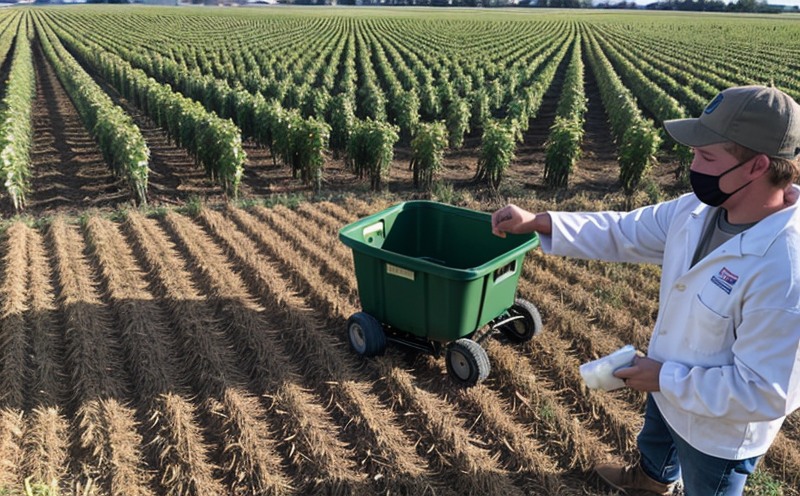Mechanical Damage Assessment in Post-Harvest Crops
The assessment of mechanical damage in post-harvest crops is a critical step in ensuring that food products reach consumers in optimal condition. This process involves evaluating the physical integrity and quality of harvested crops to minimize losses, enhance shelf life, and maintain nutritional value. Mechanical damage can occur during harvesting, transportation, storage, and handling processes, leading to reduced crop quality and potential economic losses for producers.
In post-harvest quality testing, mechanical damage is typically assessed using a combination of visual inspection, sensory evaluation, and quantitative methods. Visual inspections are often the first step in identifying visible signs of damage such as bruises, cracks, or splits on the fruit or vegetable surface. Sensory evaluations involve assessing the texture, aroma, and taste to determine if there has been significant quality degradation.
Quantitative assessments may include measuring weight loss, evaluating firmness using penetrometers, or analyzing microbial growth. These tests are conducted in accordance with international standards such as ISO 13652:2019 for fruit and vegetable quality grading, which provides guidelines for the assessment of mechanical damage.
Advanced instrumentation is also used to provide more detailed insights into the extent and nature of damage. Non-destructive testing (NDT) techniques like X-ray fluorescence (XRF), near-infrared spectroscopy (NIRS), and acoustic emission analysis can detect internal structural changes that may not be apparent through visual or sensory means alone.
Post-harvest mechanical damage assessment is essential for maintaining the quality of agricultural produce, ensuring compliance with regulatory standards, and enhancing marketability. By accurately identifying damaged areas early in the supply chain, farmers, processors, and retailers can take corrective actions to reduce further losses and improve overall product quality.
- Visual inspection
- Sensory evaluation
- Weighing for weight loss measurement
- Firmness testing using penetrometers
- Microbial growth analysis
- X-ray fluorescence (XRF) scanning
- Near-infrared spectroscopy (NIRS)
- Acoustic emission analysis
Eurolab Advantages
At Eurolab, we leverage our extensive experience in agricultural and food testing to deliver precise and reliable mechanical damage assessments. Our state-of-the-art facilities are equipped with the latest technology, ensuring consistent results that meet international standards.
- Absolutely accurate measurements of weight loss through digital scales
- High-resolution penetrometers for firmness testing
- Advanced spectroscopic instruments capable of detecting internal damage
- Expert analysts trained in visual and sensory evaluation techniques
- Comprehensive reports that provide actionable insights into reducing post-harvest losses
We offer rapid turnaround times, ensuring that your crops are evaluated promptly so you can make informed decisions about next steps. Our commitment to quality is reflected not only in our testing methods but also in our adherence to the highest ethical and environmental standards.
Why Choose This Test
Selecting mechanical damage assessment as part of your post-harvest quality control strategy offers several key benefits. First, it helps you maintain consistent product quality throughout the supply chain, reducing customer complaints and returns. By identifying damaged crops early, you can implement corrective measures to prevent further deterioration.
Secondly, this testing ensures compliance with regulatory requirements and industry best practices, thereby protecting your brand’s reputation and market position. Consumers increasingly demand products that are not only safe but also of superior quality. Demonstrating adherence to rigorous testing protocols can significantly enhance consumer trust.
Thirdly, mechanical damage assessment aids in optimizing resource allocation within the supply chain. By pinpointing where and how much damage occurs, you can allocate resources more effectively, such as reprocessing damaged items or discarding them appropriately. This leads to more efficient operations and potentially higher profits.
In conclusion, investing in mechanical damage assessment is an investment in your business’s future success. It enables better decision-making, improved customer satisfaction, enhanced regulatory compliance, and ultimately, greater profitability.
Competitive Advantage and Market Impact
The ability to accurately assess mechanical damage in post-harvest crops provides a significant competitive edge in the agricultural sector. Consumers are becoming more discerning about product quality, and those who can consistently meet these expectations will gain market share.
- First mover advantage: Early adoption of advanced testing methods allows businesses to stay ahead of competitors
- Enhanced consumer trust: Reliable test results build confidence in the brand’s commitment to quality
- Informed decision-making: Accurate data enables better resource allocation and operational efficiency
- Increased market competitiveness: Superior product quality attracts more customers, leading to higher sales volumes
- Economic sustainability: Reduced losses from post-harvest damage translate directly into increased profitability
- Environmental responsibility: Efficient use of resources minimizes waste and environmental impact
In the global agricultural market, where competition is fierce and consumer expectations are high, having robust mechanical damage assessment capabilities can be the difference between success and failure.





